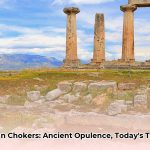Imagine a world without modern drugstores or cosmetic counters, where the quest for beauty was a daily ritual deeply interwoven with social status, health, and even morality. In ancient Rome, looking good wasn’t just about vanity; it was a profound statement. From the gleaming whiteness of aristocratic skin to eyes intensified with mysterious kohl and hair styled into elaborate towers, Roman men and women embarked on a fascinating, sometimes perilous, journey of self-adornment. The Romans also adorned themselves with beautiful Roman jewelry.
Their beauty routines were a captivating blend of nature’s bounty, rigorous daily habits, and ingredients that would certainly raise a modern eyebrow (or two!). Join us as we delve into the audacious world of ancient Roman cosmetics – uncovering their ideal standards, surprisingly resourceful ingredients (some with shocking side effects), the dedication required for daily application, and the intense societal debates sparked by their widespread use. Discover how these ancient practices, despite their primitive nature, offer timeless insights into personal expression and self-care that resonate even in today’s beauty landscape.
The Roman Ideal: Beauty as a Social and Moral Statement
In ancient Rome, beauty was far more than an aesthetic preference; it was a powerful social code. One’s appearance communicated wealth, status, and even moral character. The most coveted feature for women was pure white skin, a stark declaration of aristocratic leisure that signaled one was affluent enough to avoid working outdoors under the sun. This ethereal paleness was so paramount that Romans went to extraordinary lengths, often with dangerous consequences, to achieve it.
Achieving the Coveted Pale Complexion:
To obtain this esteemed pallor, Roman women (and some men) famously applied face whiteners such as chalk powder, white marl, and the notoriously toxic white lead (cerussa). Despite knowing lead’s poisonous nature, its use was widespread, underscoring the extreme measures taken for beauty. Wealthier women like Cleopatra VII and Empress Poppaea Sabina even indulged in bathing in donkey milk, using its lactic acid to exfoliate and soften their skin – an expensive and luxurious treatment. For daily preparations, beauty masks made from ingredients like sheep’s wool sweat (lanolin), honey, eggs, and various plant extracts were common. Some recipes were truly unconventional, including animal placenta, marrow, or even the ashes of snails for treating freckles. The discovery of a 2nd-century London cosmetic pot containing animal fat, starch, and tin oxide reveals “safer” alternatives were also developed, with tin serving as a less toxic pigment than lead.
Eyes That Command and Lips That Blush
The eyes were considered pivotal in Roman beauty, reflecting not just aesthetics but also deeper ideals. Romans esteemed large, expressive eyes framed by long lashes and dark, thick eyebrows that often met in the middle, creating a distinctive “unibrow” look. This wide-eyed, “doe-like” appearance was meticulously enhanced with cosmetics, which also served ritualistic and medicinal purposes.
The Power of Kohl:
Kohl, known as stibium or collyrium to Romans, was an indispensable eye cosmetic. Composed primarily of galena (lead sulfide) or antimony sulfide, it was applied to the eyelids and eyebrows using slender applicator sticks made from wood, glass, bone, or ivory. Beyond its darkening effect, kohl was believed to protect eyes from infections and the sun’s glare, a belief corroborated by modern pharmacological studies showing galena-based kohl stimulated nitric oxide production, enhancing immune response and offering antibacterial protection. Its dark pigment also absorbed ultraviolet radiation, making it a protective shield. Lower-class women often used soot from oil lamps as a more accessible alternative, while elite women might use saffron for its brightening effect. Green eyeshadow, derived from malachite, and blue, from azurite, were also applied to accentuate the eyes, with green being particularly popular.
Cheeks and Lips with a Healthy Flush:
While a pale face was highly prized, a delicate pink flush on the cheeks signified good health. Sources of rouge included Tyrian vermillion, rose and poppy petals, red chalk, alkanet, and even, surprisingly, crocodile dung. Red ochre, a more expensive blush, was imported from Belgium. Despite the knowledge that cinnabar and red lead were poisonous, they were extensively used for their vibrant color. Cheaper alternatives included mulberry juice and wine dregs. The Romans generally disliked overly dramatic makeup, preferring a natural appearance as a sign of chastity, with excessive use being viewed as seductive or immoral. Although evidence for eye and cheek makeup is abundant, there is no strong archaeological evidence to suggest Romans colored their lips with what we would recognize as lipstick. They might have used the same red dyes intended for cheeks, such as fucus (a generic term for red cosmetics from algae or lichens), to achieve a subtle, healthy tint.
Hair as a Canvas: Styles, Dyes, and Statements
Hair was a flamboyant canvas for Roman self-expression, with styles and colors constantly evolving to reflect wealth, status, and fashion. Both women and men invested significant time and resources into their hair, often with the help of specialized slaves called ornatrix.
Elaborate Coiffures and Hair Dyes:
Women’s hairstyles could be incredibly intricate, featuring towering layers of curls, braids, and buns, often adorned with jewels, ribbons, and hairpins (acus) made of precious metals or carved ivory. These complex styles required the use of curling irons called calamistrum—hollow metal rods heated in hot ash—around which locks of hair were wound.
Changing hair color was also popular. Blonde and red hair were highly coveted, influenced by contact with Germanic and Gallic peoples. Bleaching agents included mixtures of goat fat and beechwood ash, or saffron rinses. For jet-black hair, some grotesque recipes existed, such as fermenting leeches in red wine for 40 days. When natural hair wasn’t enough, wealthy women sported wigs (capillamenta), often made from real human hair (blonde from Northern Europe, black from India), with Empress Faustina the Elder reportedly owning over 300. Men generally kept their hair short and neatly groomed, though dyeing hair blonde gained popularity for men during Emperor Commodus’s reign. Emperor Otho and Domitian famously wore subtle wigs to conceal baldness.
The Pursuit of Smooth Skin:
Beyond the hair on their heads, body hair was considered unattractive for Roman women. Common hair removal methods included shaving with bronze razors, plucking with tweezers, waxing with resin paste, or scraping with pumice stones. Older women faced ridicule for depilation, as it was primarily associated with preparation for sex. For men, moderate hair removal was acceptable, but excessive depilation was seen as effeminate.
The Roman Beauty Routine: A Holistic Ritual
For Romans, applying cosmetics transcended mere beautification; it was a deeply embedded ritual, often a private affair conducted in a small room where men typically did not enter. This extensive beauty regimen began with the fundamental Roman practice of communal bathing in grand public baths, followed by meticulous cleansing and the precise, often time-consuming, application of each cosmetic product. Due to weather conditions and the poor composition of many products, cosmetics often needed to be reapplied several times a day.
Tools of the Trade and Fragrant Finishes:
Cosmetic toolkits unearthed by archaeologists reveal mortars for mixing ingredients, spatulae, and spoons for application. Mirrors, primarily hand mirrors made of polished metal or mercury behind glass, were essential tools, though spending too much time in front of one was seen as a sign of weak character. Cosmetics came in tablet or cake form, sold in marketplaces, with wealthier women opting for expensive makeup in elaborate containers made from gold, wood, glass, or bone. Glassblowing, invented in the 1st century CE, made containers more affordable. Interestingly, gladiator sweat and animal fats from arena fights were sold in souvenir pots outside games, believed to improve complexion.
Finally, scent was paramount. Perfumes were incredibly popular, worn by both men and women, and believed to signify health and status, masking the stench of some cosmetic ingredients. They came in liquid, solid, and sticky forms, often made through maceration of flowers or herbs in oil. The most prominent perfume market was Seplasia in Capua. Perfumes like omphacium (from unripe olives), opobalsam (balsam of Judea), Susinum (lily-based), and Telinum (fenugreek, marjoram, clover) were luxurious imports, leading Emperor Tiberius to famously complain about the vast wealth Rome spent on foreign fragrances. Deodorants made from alum, iris, and rose petals were also common. Perfumes were even used in food and to freshen homes, illustrating their pervasive role in daily life.
Controversies & Criticisms: The Enduring Debate
The widespread use of Roman cosmetics, particularly by women, was a hotbed of controversy. Prominent male authors like Juvenal, Seneca, and Clement of Alexandria frequently lambasted cosmetics as deceptive, unnatural, and a sign of moral decay, associating excessive adornment with immorality and even prostitution (lenocinium). They accused women of using makeup to conceal their true selves or to seduce, questioning their chastity and challenging male authority. The mirror itself was often depicted as a symbol of vanity. Even men who used cosmetics, like face-whitening makeup or excessive perfume, were scorned as effeminate.
In stark contrast, the poet Ovid stood almost alone in his approval, stating in Medicamina Faciei Femineae (Art of Beauty), “Let each girl enhance her beauty as best she can: art, too, is a part of beauty.” He acknowledged makeup as a tool of expression for women in a society that offered them little liberty, allowing them to project a self-constructed image. This ancient debate between societal expectations, individual expression, and gender roles continues to echo in discussions about beauty today, highlighting the complex interplay between appearance, morality, and social perception.
Actionable Insights: Unearthing Timeless Beauty Wisdom
What enduring lessons can we glean from the fascinating world of ancient Roman cosmetics for our contemporary lives? Surprisingly, there’s a wealth of applicable wisdom, encouraging a more mindful and holistic approach to beauty.
- Prioritize Natural Ingredients with Purpose: The Romans extensively utilized nature’s bounty—olive oil, honey, various herbs, and plant extracts—in their skincare and beauty products. While avoiding their toxic choices, we can adopt this principle by consciously seeking out modern products with transparent, plant-based formulations. Look for ingredients that nourish, protect, and heal, mirroring the Romans’ practical focus on the inherent benefits of natural elements.
- Embrace Multi-Tasking Products: The Roman kohl served a dual function, not just enhancing eyes but also offering antibacterial protection. Inspired by this resourcefulness, integrate multi-purpose products into your routine today. A tinted balm that hydrates lips and colors cheeks, or a serum that targets multiple skin concerns, can streamline your regimen, reduce waste, and simplify your beauty arsenal.
- Cultivate Sustainable Beauty Practices: The Romans were adept at repurposing natural elements and minimizing waste within their means. We can emulate this by making sustainable beauty choices: opting for refillable containers, supporting brands committed to ethical sourcing and minimal packaging, and reducing overall consumption. Consider DIY recipes for simple masks or oils if you enjoy crafting, much like Roman women prepared their own concoctions.
- Integrate Beauty as a Self-Care Ritual: For Romans, bathing and grooming were not rushed chores but deliberate acts of self-care and mental well-being. Take inspiration from their dedication. Transform your own beauty routine into a mindful ritual: set aside dedicated time, savor the process, use products with pleasant textures and scents, and consider it an opportunity for relaxation and rejuvenation rather than just a necessity. This shift in perspective can transform daily tasks into moments of profound self-connection.
Bridging Ancient Wisdom and Modern Beauty
| Principle | Ancient Roman Application | Modern Adaptation |
|---|---|---|
| Natural Sourcing | Olive oil, honey, herbs; problematic use of lead, animal excrement. | Focus on ethically sourced, plant-based ingredients; avoid harsh chemicals and toxic historical elements. |
| Multi-Functionality | Kohl for aesthetic and medicinal purposes. | Serums with multiple benefits; tinted balms for lips and cheeks; conscious product choices for maximum utility. |
| Ritual & Well-being | Elaborate bathing, private application aided by Cosmetae. | Transform routine into mindful self-care; dedicate time for pampering; use products that align with personal wellness goals. |
| Status & Expression | Pale skin for wealth; elaborate hair for social standing. | Beauty as personal expression regardless of societal norms; ethical brand support; challenging narrow beauty standards. |
| Resourcefulness & Sustainability | Repurposing wine dregs; tin oxide as lead substitute. | Emphasize refillable packaging, upcycling; support brands with circular economy models; reduce consumption and waste. |
Unearthing Timeless Beauty Wisdom: Key Takeaways
The world of ancient Roman cosmetics offers a captivating lens through which to understand a society deeply concerned with appearance, social standing, and personal expression. While their specific ingredients and techniques might seem shocking—from the pervasive use of toxic lead to the surprising inclusion of animal by-products—the underlying human motivations are strikingly familiar. The Romans instinctively understood the transformative power of beauty, recognizing it as a means of self-expression, social signaling, and even a crucial form of self-care.
- Cosmetics as Status Symbols: Beauty products were powerful indicators of social status, wealth, and moral standing, with pale skin being a prime example of aristocratic leisure.
- Dual-Purpose Products: Many Roman cosmetics, like kohl, served both aesthetic and medicinal functions, highlighting an early understanding of multi-tasking products.
- Resourceful, Albeit Risky, Ingredients: Romans creatively utilized natural resources, but often at great health risk due to a lack of scientific understanding of toxicity.
- Elaborate Rituals: Beauty was a time-consuming, deeply ingrained ritual, emphasizing the importance of dedicated self-care.
- Societal Debates: The use of cosmetics sparked intense moral and social debates, reflecting enduring tensions between natural appearance, artifice, individual expression, and societal expectations.
- Pervasive Perfume Culture: Fragrances were highly valued, used by both sexes to signify health, status, and to mask odors in an era before modern hygiene.
The ingenuity and dedication demonstrated by the Romans in their pursuit of beauty continue to intrigue and inspire. While we wisely leave behind the toxic lead and unconventional animal ingredients, we can certainly embrace the enduring spirit of their resourcefulness, their focus on natural elements, and their profound understanding of beauty’s transformative power. Craft your own modern Roman-inspired beauty ritual, prioritizing safety, mindfulness, and conscious choices, and connect with the timeless human desire to adorn, express, and empower oneself.










